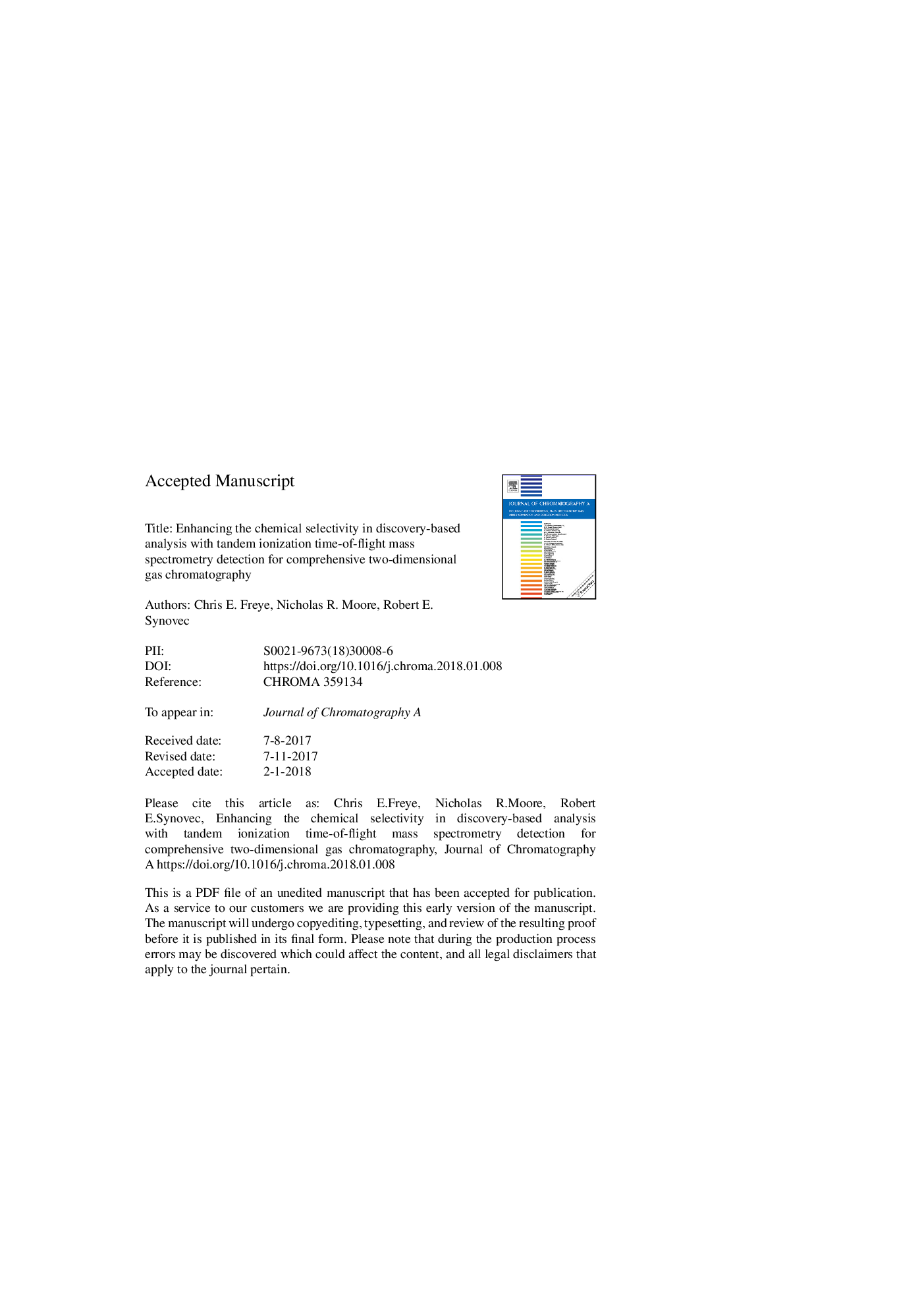| کد مقاله | کد نشریه | سال انتشار | مقاله انگلیسی | نسخه تمام متن |
|---|---|---|---|---|
| 7608837 | 1493389 | 2018 | 38 صفحه PDF | دانلود رایگان |
عنوان انگلیسی مقاله ISI
Enhancing the chemical selectivity in discovery-based analysis with tandem ionization time-of-flight mass spectrometry detection for comprehensive two-dimensional gas chromatography
ترجمه فارسی عنوان
افزایش انتخاب شیمیائی در تجزیه و تحلیل مبتنی بر کشف با تشخیص اسپکترومتری از زمان پرواز از طریق یونیزاسیون برای کروماتوگرافی گاز جامع دو بعدی
دانلود مقاله + سفارش ترجمه
دانلود مقاله ISI انگلیسی
رایگان برای ایرانیان
کلمات کلیدی
موضوعات مرتبط
مهندسی و علوم پایه
شیمی
شیمی آنالیزی یا شیمی تجزیه
چکیده انگلیسی
The complementary information provided by tandem ionization time-of-flight mass spectrometry (TI-TOFMS) is investigated for comparative discovery-based analysis, when coupled with comprehensive two-dimensional gas chromatography (GCâ¯Ãâ¯GC). The TI conditions implemented were a hard ionization energy (70â¯eV) concurrently collected with a soft ionization energy (14â¯eV). Tile-based Fisher ratio (F-ratio) analysis is used to analyze diesel fuel spiked with twelve analytes at a nominal concentration of 50â¯ppm. F-ratio analysis is a supervised discovery-based technique that compares two different sample classes, in this case spiked and unspiked diesel, to reduce the complex GCâ¯Ãâ¯GC-TI-TOFMS data into a hit list of class distinguishing analyte features. Hit lists of the 70â¯eV and 14â¯eV data sets, and the single hit list produced when the two data sets are fused together, are all investigated. For the 70â¯eV hit list, eleven of the twelve analytes were found in the top thirteen hits. For the 14â¯eV hit list, nine of the twelve analytes were found in the top nine hits, with the other three analytes either not found or well down the hit list. As expected, the F-ratios per m/z used to calculate each average F-ratio per hit were generally smaller fragment ions for the 70â¯eV data set, while the larger fragment ions were emphasized in the 14â¯eV data set, supporting the notion that complementary information was provided. The discovery rate was improved when F-ratio analysis was performed on the fused data sets resulted in eleven of the twelve analytes being at the top of the single hit list. Using PARAFAC, analytes that were “discovered” were deconvoluted in order to obtain their identification via match values (MV). Location of the analytes and the “F-ratio spectra” obtained from F-ratio analysis were used to guide the deconvolution. Eight of the twelve analytes where successfully deconvoluted and identified using the in-house library for the 70â¯eV data set. PARAFAC deconvolution of the two separate data sets provided increased confidence in identification of “discovered” analytes. Herein, we explore the limit of analyte discovery and limit of analyte identification, and demonstrate a general workflow for the investigation of key chemical features in complex samples.
ناشر
Database: Elsevier - ScienceDirect (ساینس دایرکت)
Journal: Journal of Chromatography A - Volume 1537, 16 February 2018, Pages 99-108
Journal: Journal of Chromatography A - Volume 1537, 16 February 2018, Pages 99-108
نویسندگان
Chris E. Freye, Nicholas R. Moore, Robert E. Synovec,
